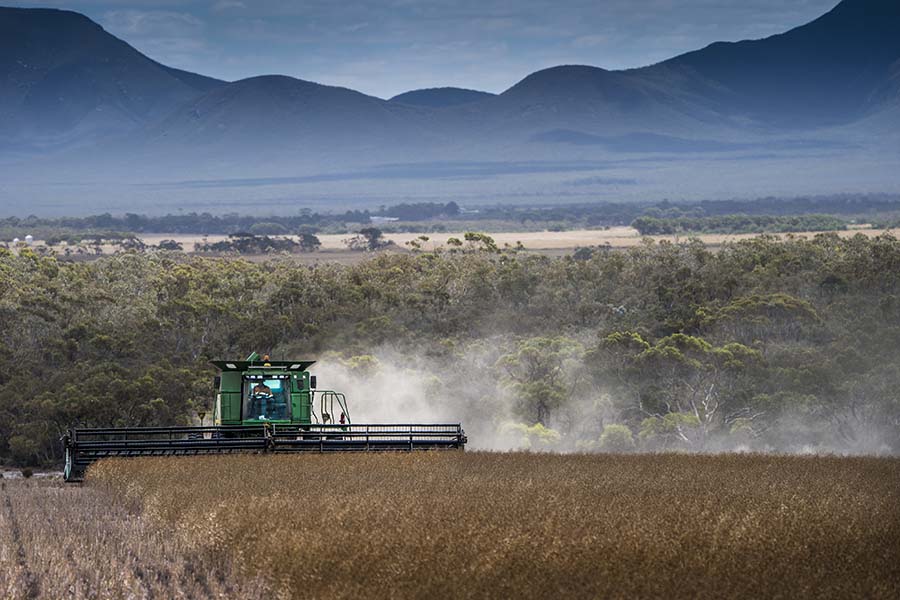Results from deep-ripped trials in deep white sand in Western Australia's south coastal region have revealed short-term crop yield increases only, suggesting growers with this soil type should not anticipate long-term profits from deep ripping.
However, growers could still consider investing in deep-ripping, as long as their return-on-investment calculations are based on projected results from just one or two years.
Deep-ripping shows short-term gains
The GRDC-invested paddock trials, overseen by the Western Australian Department of Primary Industries and Regional Development (DPIRD), have been running since 2014 on the Kojaneerup property of Josh and Shannon Goad.
The Goad property is typical of the south coastal region, with deep white sand over gravel and clay, and has the twin soil constraints of water repellency and a compaction layer at depth.
The Goads have been claying their paddocks for many years in an attempt to alleviate this water repellency challenge.
While Josh says the longer-term yield responses from the trials were disappointing, the significant short-term results make the investment (machinery costs, fuel and time) worth his while and he will continue to deep-rip paddocks every few years to alleviate compaction.
Yield results

In fact, Josh believes he achieved a return on investment from deep-ripping in just one year.
He says until they use a fully controlled-traffic farming (CTF) system, the family will continue to deep-rip to a depth of 700 millimetres every two years prior to a cereal crop.
"This is because the strategy provides enough return for us to warrant spending money on it," he says.
In 2014, Josh shallow-ripped treatments down to a depth of 350mm, but found the crop yield results were not substantial.
In 2015 and 2016, he deep-ripped further treatments to depths of 700mm and 1200mm to see if this would have a more significant impact on yields.
The 1200mm deep-ripped treatments were completed using a bulldozer and, while perhaps not practical for application across an entire broadacre property, the results were particularly interesting from a research point of view.
DPIRD senior research officer Jeremy Lemon says yield responses in the deep and very-deep-ripped treatments were significant in the first year after the amelioration - up to 1.4 tonnes per hectare over the control in the treatment (which was ripped to a depth of 1200mm).
But, he says, while there was still a yield response in the second year, the improvements were less than expected.
By the third year, Mr Lemon says, there was no remaining yield benefit from the deep-ripped treatments.
"We think this short-term result was because of a number of reasons, including waterlogging, frost and multiple vehicle tracks across the paddocks," he says.
Josh Goad harvesting canola at Kojaneerup, WA. Photo: Evan Collis
Prolonging the benefits
Seeing this level of re-compaction in the soils, not only after the waterlogging event but also after each annual spraying and spreading program, has inspired Josh to progress his plan to move to a fully CTF system. The Goads recently purchased a new sprayer and, over the next five years, they plan to change a tractor and a spreader over to 12-metre widths, with wheel tracks on three-metre centres, to better protect their deep-ripping investment.
"Our business is constantly changing and adapting to new challenges and we will continue to try new ways to reduce our major constraints of water repellency and compaction," Josh says.
Fast return on investment
Yield data from the Goads' trial has been analysed as part of a further GRDC-invested project, managed by agricultural consultants AgVivo and DPIRD.
The aim is to better understand not only the yield responses, but also the return on investment of the different deep-ripping treatments.
In 2018, it was reported in GroundCover™ that the Goads' had outstanding 1.4t/ha yield increases on the first-year barley crop in the deep-ripped treatment using a bulldozer to 1200mm.
But the recent AgVivo economic analysis shows a very different story.
The most profitable outcome over the three years of data collection came from the treatment ripped to a depth of 700mm, suggesting there is little value in ripping beyond the hardpan compaction layer.
The 700mm ripping treatment returned $128/ha across the three years of data.
Even though the 1200mm treatment gave the largest yield increase - with a $283/ha benefit in 2016 - the high yield results were a one-off occurrence and the high cost of the treatment reduced the overall return on investment.
The 350mm ripping treatment only just broke even between 2016 and 2018, returning $1/ha.
"Clearly this was not deep enough to penetrate and break up the whole depth of the hardpan compaction layer to allow root penetration deeper into the subsoil," Mr Lemon says.
He says based on these results, and on the experience of other growers across the south coastal region, the cost of any deep ripping must be recouped in the first two seasons to make it a worthwhile investment.
"This means growers shouldn't rely on long-term results to justify the initial soil amelioration investment," he says.
Josh says frosts and waterlogging in 2017 would have contributed to the poor canola yield results seen in 2017.
The soil had also largely compacted by 2018, which contributed to the short-term results.
Impact of the hardpan
Mr Lemon says sandy soils re-compact naturally through wetting and drying cycles and, after the waterlogging event in 2017, the soil would have compacted as it dried out.
"As the water dries out from the soil, it pulls the sand particles back together again, creating natural compaction," he says.
"Perhaps this raises other issues for growers in this region, in regard to drainage opportunities, to better protect any investment in soil amelioration."
Grower group Stirlings to Coast Farmers is managing further GRDC-invested trials in the region.
These trials include research on the Goads' property. The trials are further investigating the responses from a range of soil amelioration treatments.
More information: Jeremy Lemon, DPIRD, jeremy.lemon@dpird.wa.gov.au; GRDC-invested Soil Constraints - WA has links to a range of valuable resources for the western region at https://grdc.com.au/news-and-media/audio/podcast/soil-constraints-wa

























































